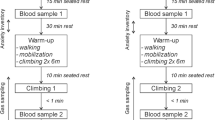Abstract.
As the numbers of middle-aged and elderly mountain climbers have increased with the general aging of the population, accidents during mountain climbing have increased recently. A possible cause of such accidents is an excessively difficult expedition plan. To enjoy safe mountain climbing, the plans must take account of the climber's fitness level. We developed a method to plan mountain climbing using the climbing heartbeat index (CHI). This study is based on the assumption that the work expended when climbing a mountain is equal to the potential energy of the body and load weights elevated to the height of the mountain, and that the work is proportional to the heart rate. The CHI was calculated by the following equation
The CHI values examined in this study (n = 94) showed very small standard deviations and were significantly correlated with the maximum oxygen uptake, V̇O2 max (ml kg–1 min–1) (r = –0.934, P < 0.01); it showed a characteristic value corresponding to the fitness level in each subject. In addition, this value remained nearly unchanged even when the load was changed. Therefore, if the CHI value of an individual is known (it can be estimated from V̇O2 max), safer mountain climbing can be planned accordingly. Once determined, this CHI value can be used repeatedly unless the fitness level of the individual changes.






Similar content being viewed by others
References
Eston RG, Rowlands AV, Ingledew DK (1998) Validity of heart rate, pedometry, and accelerometry for predicting the energy cost of children's activities. J Appl Physiol 84:362–371
Horikawa T (2000) Hiking world. Tozan Jihou 306:15–22
Katagiri N (1998) Report of mountain accidents. Jpn J Mount Med 18:127–129
Strath SJ, Swartz AM, Bassett DR, Obrien WL, King GA, Ainsworth BE (2000) Evaluation of heart rate as a method for assessing moderate intensity physical activity. Med Sci Sports Exerc 32:S465–S470
Tanaka H, Monahan KD, Seals DR (2001) Age-predicted maximal heart rate revisited. J Am Coll Cardiol 37:153–156
Tanaka S, Baba Y (1998) Alpine rescue at Mt. Tanigawa: current status and problems. Jpn J Mount Med 18:119–126
Author information
Authors and Affiliations
Corresponding author
Rights and permissions
About this article
Cite this article
Sakai, A., Nose, H. Safer mountain climbing using the climbing heartbeat index. Int J Biometeorol 48, 15–19 (2003). https://doi.org/10.1007/s00484-003-0167-1
Received:
Revised:
Accepted:
Published:
Issue Date:
DOI: https://doi.org/10.1007/s00484-003-0167-1




